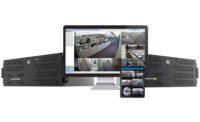Don’t be fooled by the nickname, “Little Rhody.” While the entire state of Rhode Island may have fewer residents than the city of Dallas, the Rhode Island Turnpike and Bridge Authority (RITBA) pulled out all the stops when it came to securing the structures that allow safe travel in the coastal area of Rhode Island and its neighboring states.
The Claiborne Pell Bridge and the Mount Hope Bridge see an average of 27,000 vehicles each day. As a state with several large bays and inlets, drivers depend on the bridges to connect them to and from their destinations. After a complete renovation of the main RITBA administration building and an upgrade to the aging Bridge Toll booth and EZ pass lanes, RITBA set its sights on a new goal: a state-of-the-art, multi-faceted security solution. RITBA contracted SIGNET Electronic Systems Inc., a New England-based systems integrator to steer the project.
The contract, which was valued at approximately half a million dollars, was awarded to SIGNET based, in part, on its continued relationship with a prominent electrical contractor, as well as the company’s abilities in the field. “After RITBA completed a walkthrough of a recent SIGNET implementation at the Rhode Island State Police Headquarters, which had a similar scope, the RITBA team was as impressed as they were eager to have SIGNET complete their own design and installation,” said Jason Bianco, senior account executive at SIGNET.
SIGNET’s turnkey scope was the design, furnishing, installation, commissioning, owner training and warranty of the integrated technology systems throughout the new administration building, toll lanes and underground passage tunnel. The systems included integrated IP video surveillance, access control, audio visual systems, public address, intercom, and dedicated IP network and structured cabling for the building, toll lanes, maintenance garage and passage tunnel.
One of RITBA’s requirements was to capture highly detailed images, both during the day and at night, of rapidly moving vehicles as they passed through the toll stations. To meet that requirement, SIGNET installed more than 42 high-speed, high-resolution video surveillance cameras, allowing RITBA administrators to view toll collection booths and vehicle lanes and to easily identify license plate information.
“Because the cameras are intended to record each vehicle’s details while passing through the toll lanes, including at night, the coordination of cable pathways and the locations of the cameras were of extreme importance,” described Andy Pelletier, senior project manager at SIGNET. “If not installed in the correct location, the proper viewing angles would not have been made possible.” SIGNET leveraged the experience of its engineers and installation staff to properly secure each camera and achieve the intended viewing angles.
“Because of the necessity of their location, the most challenging work proved to be the cabling and installation of these cameras on the toll booth lanes and newly installed gantry supporting the high-speed lanes,” Pelletier shared.
All cabling passed through the overhead canopy, which included an extremely tight, two-foot high crawl space. Only two lanes could be shut down at a time, so situational awareness during the work was an extreme challenge to ensure the safety of the installers.
Another major challenge was to coordinate proper lighting with the cameras. To facilitate color clarity, high-intensity LED white light illuminators were installed externally to assist with nighttime and low-light level surveillance.
In addition to capturing the images, RITBA also required a solution that would allow the video footage to be displayed on multiple displays simultaneously. In response, SIGNET installed three Samsung ME55, large LCD displays, a Mitsubishi 8200LU HD projector with dynamic quad window ability, an interactive, Panasonic PanaBoard (whiteboard) and a wireless touch panel control system (Crestron TPS6X with customized GUI) for RITBA’s Emergency Operations Center. The Crestron control and digital media distribution audio/video systems also included rack-mounted computers to provide live video feeds of local and external systems for display in the Emergency Operations Center.
Other installations that added to the complexity of the project included access control on 12 doors, and structured cabling consisting of 100 data work-area outlets, 40,000 feet of Category 6 cabling, and 1,000 feet of 10G optimized fiber optic cabling. The systems were extended to support RITBA’s renovated building, as well as the newly constructed employee-passage tunnel crossing underneath the highway. The products deployed on this system were based upon SIGNET’s best-in-class partner manufacturers. See the list to the right, left, etc.
The successful design and implementation of RITBA’s robust systems integration project was an exciting opportunity for SIGNET as it allowed the company to further cultivate its reputation for providing cutting-edge technology and customer service to the government sector. By security some of Rhode Island’s most important infrastructure, SIGNET also laid the foundation for a long-lasting partnership with RITBA.
PROJECTS in the News
Axis Communications, a provider of network video surveillance, announced that the security team at the 101th Grey Cup Festival in Regina, Saskatchewan utilized a mix of Axis thermal, fixed dome and pan/tilt/zoom (PTZ) network cameras controlled by AXIS Camera Station video management software to help protect visitors and volunteers of the five-day festival leading up to the Canadian Football League’s championship game.
Installation of the system was completed by Axis partner Reliable Security, a division of Reliable Heating and Cooling Ltd., to provide around-the-clock monitoring capabilities.
The all-Axis, end-to-end solution of IP cameras and video management software (VMS), included a mix of outdoor-ready fixed and fixed dome network cameras like the AXIS P33 Series and AXIS P13 Series, as well as the AXIS Q19 thermal network camera series to help detect people entering the Festival grounds in complete darkness and AXIS Q1602 network cameras with Lightfinder technology to provide clear color video at night.
? ? ?
Brivo Systems LLC, a provider of cloud applications for security management, announced that the city of Jeffersonville, Ind. continued to roll out the Brivo OnAirSM hosted cloud-based access control and video surveillance management solution to a number of different departments and locations throughout the city. Security Pros is the Brivo dealer and installer for this on-going project.
Chris Gilbert, founder and president of Security Pros, estimates the city manages about 30 access points with Brivo.
Recently, the city completed a $4 million renovation at Vissing Park. Problems arose because park staff locked the bathrooms at 5 p.m. upon leaving, but park users still needed facilities. Simply leaving the bathrooms open or on electronic timers invited vandalism and graffiti.
Security Pros set up automatic schedules for the two sets of bathrooms at the park and connect and transmit wirelessly. Now, the public has access from 6 a.m. to 10 p.m. and there is a record of the access for each bathroom.
Jeffersonville also recently built Highland Dog Park. By installing Brivo at the two dog park entrances and providing access cards in exchange for an annual fee, residents and their dogs can enjoy the park and know they are safe. Northam explained, “The dogs need to have five different kinds of vaccinations and all five must be up to date for the dog owner’s access card to stay valid.”
? ? ?
Maricopa County Sheriff’s Department in Phoenix, Ariz. was facing problems storing and managing multiple petabytes of video surveillance data from approximately 3,000 cameras, in addition to consolidating multiple disparate security sensor data into one common operating picture.
The Sheriff’s department turned to DataDirect Networks (DDN) and Sierra Detention Systems for an integrated high performance, high availability video surveillance technology solution, capable of seamlessly scaling from five petabytes up to as many as 30 petabytes as site requirements evolve.
DataDirect Networks (DDN) and Sierra Detention Systems had collaborated to offer a physical security solution for scalable mission-critical video surveillance applications at correctional facilities like those operated by the Maricopa County Sheriff’s Department.
The integrated security controls system was built on DDN’s SFA™ (storage fusion architecture) platform and Sierra Detention Systems’ PSIM technology.
Thousands of cameras and multiple petabytes of surveillance and sensor data are managed by Sierra’s control system, which was designed to regulate person-flow, safety and security of individuals throughout high-security and correctional facilities, commercial buildings, data centers and public and private campuses.
DDN SFA technology provides real-time bandwidth as well as optimized delivery of low-latency access to spinning (HDD) and Flash (SSD) media — resulting in what the company calls, “best-in-class IOPS performance.” The result is a highly scalable, dense and energy-efficient archive platform that is easy to setup and manage from within the interface, providing rapid access to surveillance and sensor data, according to DDN.
The fully integrated DDN and Sierra Detention Systems solution provides a single pane view of the entire security environment, powered by DDN’s scalable SFA storage architecture. When used together, the solution provides streaming of high-definition video to a single, high-density DDN system for real-time data capture and video archiving.
“Sierra Detention Systems and DDN products are highly complementary and seamlessly create the efficiencies between life safety requirements and daily facility operations of law enforcement and surveillance intensive systems. Today, our customers are benefitting from the expanded surveillance storage archiving functionality this new solution provides,” said PD Sims, Sierra Detention Systems’ director of engineering.






